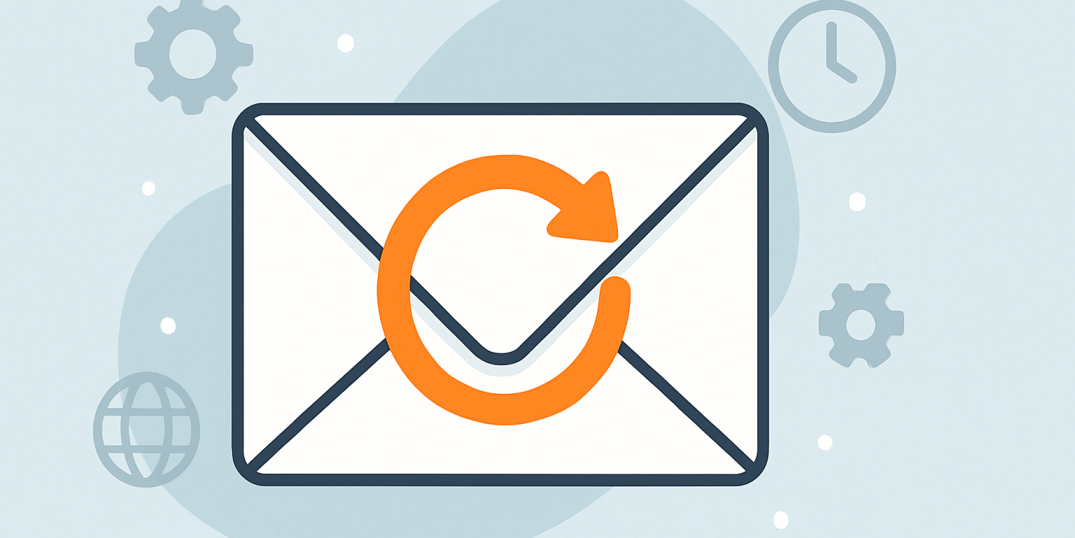- Home
- Email Tips and Tricks
- Resending Emails: Best Practic ...

Have you experienced the situation when you send an important message to someone you want to communicate with and they don’t reply? Days go by, no reply… And tensions are growing. So, how to resend an email?
Yes, email is still one of the most widely used communication tools in both personal and professional communication. However, despite its prevalence, emails can often get lost, overlooked, or misdirected for various reasons. True, there are so many obstacles! You could face busy inboxes, strict spam filters, or technical glitches. All of them can prevent your carefully crafted messages from reaching the recipient’s attention.
How do you behave in such a situation? You are facing a dilemma: should you resend the original email or send a follow-up message to prompt action? The most important thing is to understand the key differences between resending and following up. It is essential to maintain professionalism, avoid the perception of spam, and ensure your communication hits the target.
👉 To help understand whether you should or shouldn’t be resending emails, consider this University of Michigan study, which reveals some curious findings. It turned out that out of 11.3 million public emails, 7.46 million, or 65.93%, were never replied to! This astonishing number underscores the importance of a strategic approach behind your moves. You must decide when to resend or follow up.
In this article, you will explore the very up-to-date and tantalizing question: to resend or not to resend?
What Does Resending an Email Mean?
First, resending is a psychological barrier that needs to be overcome with comfort and confidence. As to the definition, resending an email means sending the same or nearly identical message again. Unlike a follow-up, its primary goal is not to prompt an immediate response but to ensure that the recipient actually receives and sees your initial message. Resending is a fairly common practice in email marketing; it is particularly useful when technical glitches or human errors prevent your original message from being found.
Typical reasons for resending
Let’s learn the three most common reasons for resending that you may face:
💎 Technical issues: Your messages may bounce back if you enter invalid addresses; temporary server errors can also occur. Besides, emails can also be misdirected to spam or junk folders, leaving the recipient unaware that you sent them a very important message. According to Litmus, spam filters are one of the most common causes of email non-delivery. Up to 70% of emails show at least one spam-related issue that could keep them out of the inbox
💎 Your recipient may have missed it: Even if your email is delivered successfully, it may be lost among dozens or hundreds of other messages. This is especially relevant for high-volume corporate inboxes. Yes, it happens: your recipient might simply have overlooked it.
💎 Mistyped subject line or attachment issue: Please be very careful here! Even a simple typo in the subject line or a missing attachment can drastically reduce the probability of engagement. The solution is to resend the original message with corrected details. This will ensure the recipient receives the intended content.

According to Mailerlite, resending an email campaign can increase the open rate of your campaign by an extra 30%.
👉 Our verdict: You should identify the reason why your original email might not have been noticed. Once the reason is identified, you can determine whether resending is appropriate and, if so, how to do it effectively, depending on the issue.
Resending vs. Following Up: Key Differences
Here are the basics: resending and following up may seem similar; however, they serve distinct purposes and require different approaches. Let’s examine the various cases that relate to both resending and following up.
| Aspect | Resending | Following up |
| Goal | Ensure delivery | Prompt action or response |
| Focus | Correcting glitches or visibility issues | Advancing communication, securing a reply, or closing a deal |
| Tone | Neutral, informative | Action-oriented, persuasive, polite reminder |
| Risks | Looks spammy if repeated too often | Risk of seeming pushy, impatient, or even aggressive |
The chart below shows the overall effectiveness of resending vs. following up.

Key takeaways:
✨ Resending is all about visibility. You are willing to make sure the recipient actually sees the original message, without necessarily urging a specific action.
✨ Following up, on the other hand, is about engagement. In this case, you are prompting the recipient to respond or take a particular step. This may often include additional context or incentives to encourage action. By the way, take a look at this Sendigram article on various kinds of follow-ups.
👉 Our verdict: Remember, it’s essential to adjust the tone and language of your messages accordingly. A poorly timed or overly frequent resend can be perceived as spam. At the same time, an aggressive follow-up is another side of the coin because it may alienate the recipient or damage your professional reputation.
When to Resend and When to Follow Up
So, how to resend an email that was not answered? One thing is certain: knowing when to resend and when to follow up is crucial for you to maintain professionalism and ultimately achieve success as a marketer or business owner. Let’s check out both cases:
Resending is best when:
⭐ Your email bounced or was flagged as spam. The perfect time to make another try and resend an email.
⭐ You have clear evidence at hand that the recipient never opened the original message.
⭐ You must correct mistakes in the original email, such as subject line typos, missing attachments, or even broken links; the last thing is really a problem!
Following up is best when:
⭐ You sent the message, the recipient opened your email but did not respond.
⭐ You are in the middle of negotiation or a promising project that requires progress or input. Don’t wait, go for it!
⭐ You want to gently remind the customer to act on your previous request. Perhaps, you should provide additional information or clarify next steps.
To learn how to turn silence into opportunity, look for this cold email follow-up guide by Sendigram.
How to use email analytics to know what to do
As you know, contemporary email platforms provide great insights into whether your email was opened, clicked, or, alas, ignored. Rely on stats like open rates, click-through metrics, and delivery confirmations. These things can actually shape your strategy. Think about it: a message never opened may justify a resend, while an opened but unanswered email signals the need for a follow-up. That’s the difference! According to Walla online marketing agency, resending a campaign to non-openers can boost open rates by up to 30%, click-through rates by 14%, conversion rates by 26%, and ROI by 29%. On the other hand, cold outreach follow-ups can lift responses by 20–27%, as stated by the Manyreach cold emailing platform.
👉 Our tip: Consider implementing a structured timeline for resends and follow-ups to ensure timely communication. Set your goals, like allowing at least 48–72 hours before resending an email. For a follow-up, a pause of three to five days would be fine before taking action. This way, you will ensure your communication is timely without being intrusive or pushy.
Best Practices for Resending Emails
The core question is How do I resend an email properly? Let’s look at practical steps you can take. Resending emails is more effective when done with a thoughtful and energetic approach. Here are the best practices for effective resending:
- Change the subject line slightly: If you want to avoid spam filters and catch the recipient’s attention, you should modify your email’s subject line. Don’t write a lot because even a minor adjustment, such as adding “Follow-up” or “Updated Info,” can make a difference.
- Add a short note explaining why you’re resending: You can include just several words, such as “Resending in case you missed our previous email.” This way, you will provide context and show courtesy.
- Double-check recipient details and attachments: Ensure the recipient’s email address is correct and that any attachments or links are properly included.
- Patience is the key: Some people can’t wait to reach the recipient but choose a no-rush mode. We recommend you avoid sending a second message immediately. Just wait for two or three days. This will give the recipient time to notice your original message and reduce the risk of appearing spammy.
- Keep it concise: Also, try to avoid rewriting the entire email unless necessary. A brief reminder is sufficient to draw attention to the original message.
👉 Our verdict: Following these guidelines will help you ensure that your emails reach the recipient properly. At the same time, you will maintain a professional and respectful tone while resending emails.
To Sum Up
Well, now you know how to resend an email politely, right?
First, draw the line when it comes to resending and following up. These are distinct strategies that serve different purposes in professional email communication. Resending is about ensuring that your message reaches the recipient and is visible. On the other hand, following up focuses on prompting action or response. The key thing is to understand the difference. We strongly recommend you use analytics to guide your approach and apply best practices. This way, you can communicate more effectively, avoid appearing pushy, and increase the probability of receiving a response.
So remember—when your inner voice screams Send it again!—take a deep breath. Consider the reasons why your message hasn’t been replied to. Then, shape your strategy: is it a matter of resending or following up? If you decide it is the former, look for the best practices we provided in this article.
And only when everything is cleared and ready for action, shoot!



